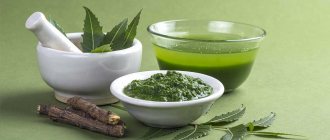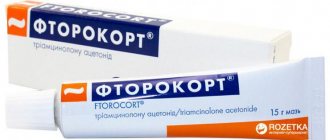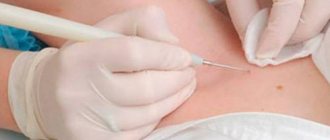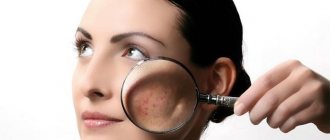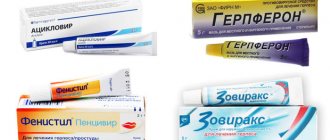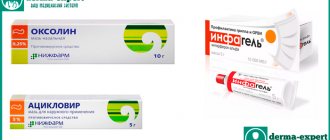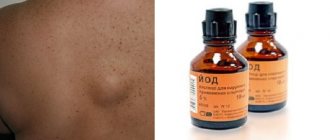Psoriasis is a chronic disease in which the division of skin cells is disrupted. Rashes form on the skin, causing itching, pain, and deterioration in physical condition. The disease cannot be cured, but it can be put into remission. Psoriasis in the ears usually develops after damage to the scalp. At the same time, it often affects the neck, forehead, and back of the head.
Lack of timely treatment leads to skin infection and severe inflammation. What are the causes and distinctive signs of the disease, what treatment methods exist?
Clinical picture
Separately, the ears rarely succumb to rashes. In addition to them, damage to a wide area of the scalp, temporal region, lobes and folds is often observed. It happens that a rash forms in the middle of the ear canal, where it is not visible at all, and this delays the start of therapy and complicates the course of the disease. Peeling in this area occurs only when large areas of the scalp are damaged.
Sometimes the high-speed separation of cells is distributed over the face, neck, and décolleté. It is impossible to predict where exactly the pathology will spread. Spots can appear on the earlobes, and only then on the face and neck. The ear canal and internal part are most often affected.
Before starting treatment for psoriasis, it is necessary to ensure the accuracy of the diagnosis. It is practically impossible to completely get rid of the disease; it is only possible to suppress the symptoms with the appearance of a long-term remission. If left untreated, the affected area increases and the symptoms worsen.
Psoriasis acts at the cellular level, significantly reducing human immunity. In this regard, the patient develops other pathologies that can lead to serious consequences.
Symptoms of the disease
Psoriasis in the ears can occur at any age: both in children and in the elderly. The disease is characterized by manifestations that give the patient a lot of discomfort.
The main signs of psoriasis in the ear:
- Irritative processes in the dermis of the ears.
- Unbearable itching.
- Excessive dryness of the skin of the ears, the presence of small cracks.
- Many spots with a pronounced reddish tint.
- The presence of scales that constantly peel off.
- In some cases, swelling of the ear may occur.
Patients often confuse ear psoriasis with eczema or dermatitis. To avoid this and begin to treat the disease in time, it is important to know a number of distinctive features of psoriasis that are not inherent in other skin ailments:
- When the scales are scraped off, pink spots become visible.
- The dermis affected by psoriasis is covered with a thin shiny film.
- When this thin film is damaged, small drops of blood are formed almost instantly.
If the disease is not treated promptly, it can spread to other parts of the body, in particular to the face, tongue and even gums.
Causes
According to statistics, 3% of the population is affected by psoriasis. The lesion appears in men and women, regardless of age, even in young children. The reasons for the development of the disease have not yet been fully studied.
On this topic
- Psoriasis
Choosing the most effective method of treating psoriasis
- Irina Nasredinovna Nachoeva
- September 24, 2021
The main provoking factors of psoriasis are:
- hereditary predisposition (when one parent is sick, the child’s risk of development is approximately 8%, when both are 41%);
- early infections (bacteria, viruses) lead to disruption of the genetic apparatus of cells;
- nervous shock, constant stress, depression;
- pregnancy;
- unhealthy diet (vinegar, mayonnaise, smoked and fatty foods, etc.);
- alcoholic drinks (champagne, beer);
- skin injuries
- use of medications (antidepressants);
- sudden climate change;
- endocrine changes;
- allergies to household chemicals.
Psoriasis occurs in one ear or both at the same time. If motivating factors and frequent interaction with water are neglected, the disease begins to spread faster.
How to treat at home
Treatment of psoriasis with folk remedies cannot be an independent method of treatment. However, you can carry out procedures at home that will be an excellent addition to the main therapy. They can also be used to consolidate the effect and prevent.
Ointments for external use based on birch tar are popular. Egg white and tar are added to it. The use of this and other folk recipes has several advantages. Firstly, the natural base of such self-prepared products is completely natural, so their use is safe. Secondly, they do not require large financial outlays and, thirdly, their use can be long-term, and addiction usually does not occur.
Most doctors have a positive attitude towards such treatment methods, but warn about possible dangers. For example, when psoriasis becomes severely aggravated, you cannot do without hormonal ointments and it is impossible to replace them with self-prepared medications. In any case, consultation with a dermatologist is required. You can discuss your intentions to supplement treatment with one or another folk remedy with your doctor.
Symptoms
At the first stage of development, psoriasis can be recognized by the inherent itching in the sink area. Papules with noticeable peeling form in or behind the ears.
Symptoms of this form of psoriasis:
- the skin becomes tight;
- small pinkish tubercles with a peeling surface appear;
- of itching appears , followed by irritation and redness;
- inflammatory areas become swollen and red;
- sometimes there is a discharge with a foul odor;
- After some time, a white coating appears in the area of redness.
Since ear psoriasis is similar to eczema, doctors often diagnose an infectious pathology. And therapeutic measures are aimed at eliminating the infection.
Diagnostic measures
First, an anamnesis is traditionally collected and a visual examination is performed. The tuberculate crusts are microscoped. What does psoriasis on the scalp look like?
As with any form, there is a triad of symptoms:
- “paraffin lakes”; scales that can be easily removed by scraping;
- after scraping the scales, a red shiny surface is found underneath them - a symptom of psoriatic film.
- Auspitz symptom or symptom of pinpoint bleeding or “bloody dew” - appears immediately after the first two signs.
Dotted blood appears from the glossy surface. Koebner's phenomenon is the appearance of a rash after the onset of the disease 10-15 days later.
Diagnostics
Psoriasis usually develops quickly. And since at the beginning of the disease it is difficult to determine the cause, in order not to trigger it, patients are prescribed drug treatment. It helps prevent subsequent development.
To correctly establish a diagnosis, it is necessary:
- conduct a laboratory analysis of intestinal microflora;
- scrape off the psoriatic plaque - a stearin stain should appear;
- peel off the scales - the terminal film will be visible there, and if it is damaged, drops of blood will appear.
The main thing is to establish the cause of psoriasis, otherwise a relapse will occur very soon.
Diagnosis
If you suspect psoriasis behind or inside the ears, you should consult a dermatologist. The doctor must conduct a visual examination of the affected area, clarify the medical history and establish the presence or absence of the disease in close relatives, since it is known that there is a family predisposition to this disease. However, external examination alone is usually not enough. This disease is similar in its external manifestations to other types of dermatoses, in particular eczema, so the dermatologist prescribes additional tests and examinations:
- General blood analysis. This method indirectly helps to identify psoriasis by increasing the content of proteins and leukocytes in the blood.
- Scraping the affected skin. Immediately after scraping off the scales, a so-called stearin spot appears on the skin, which is an important diagnostic marker for the disease. Laboratory examination of biological material reveals the presence of specific protein bodies.
- Microflora smear. This study is carried out for the purpose of differential diagnosis. Most skin diseases have an infectious or fungal etiology, so identifying specific microorganisms can exclude psoriasis.
Treatment
Having determined the diagnosis, you need to immediately carry out therapy. The prescription for psoriasis is determined by a dermatologist separately for each person. When choosing medications, the specialist takes into account some important factors - the clinical picture, the extent of skin damage, the patient’s age, the duration of the disease and general condition.
Treatment of ear psoriasis should be comprehensive. Medications alone are unlikely to help. Although this dermatological pathology does not lead to deafness, it should not be left to chance.
Medications
Therapeutic methods are aimed at eliminating symptoms. Drug treatment of psoriatic plaques involves:
- Antibacterial agents (penicillins, cephalosporins, macrolides) are used for the formation of erosions and cracks, where infection can occur or for exacerbation of pathology.
- B vitamins
- Hormonal corticosteroid drugs are consumed in parallel with drugs based on salicylic acid (Belosarik, Diplosarik); For skin regeneration, medications with calcipotriol are used (Daivobet, others). They relieve inflammation and other symptoms of psoriasis.
- Keratolytics – help soften, moisturize and further eliminate plaques.
- Antihistamines (Claritin, Diazolin, Erius, Zyrtec) - relieve itching, redness and irritation of the skin.
- anti-inflammatory (Salicylic, Sulfur ointment, Dithranol, Zinocap, Akrustal, Antipsorin, etc.) - have an antifungal, antipruritic, analgesic effect.
- Antidepressants (available by prescription only) are prescribed when a psychological disorder manifests itself, usually caused by discomfort, severe itching, or a burning sensation in the ear.
- The use of monoclonal antibodies restores the mechanism of cell division. Currently, it is a popular method of eliminating this disease.
On this topic
- Psoriasis
Find out what blood tests you need to take for psoriasis
- Irina Nasredinovna Nachoeva
- September 24, 2021
In addition, patients with psoriasis of the auricle are prescribed enterosorbents and hepatoprotectors for oral use.
To cure the disease faster, you should provide open access to the damaged skin to clean air and sun.
How to apply medications
Properly selected treatment for ear psoriasis will help cope with pain and discomfort. The drugs will protect the skin from further irritation.
How to apply the product correctly:
- ointment, cream or gel must be smeared into the desired area with clean hands;
- apply them to the damaged area in a thick layer; when it is necessary to treat the surface of the ear, use a cotton swab; if from inside the passage - a cotton pad;
- After performing the procedure, you should wait 20 minutes, only after that go to bed or put on a hat, because the product will be erased.
For psoriatic disease behind the ears, it is helpful to jointly lubricate the outer part that is close to the affected area.
Physiotherapy
In addition to treatment with medications, physical procedures provide good results:
- Herbal medicine involves the effect of ultraviolet rays on areas of inflammation.
- Laser therapy is intended to normalize metabolic processes in the damaged area.
It is worth noting that this pathology does not tolerate amateur activity. Treating ear psoriasis requires a comprehensive and knowledgeable approach. Self-therapy will complicate the situation.
Hygiene features
When performing treatment for psoriasis, you need to adhere to simple hygiene rules:
- everyday water manipulations should not cause injury to the affected areas;
- dry all areas thoroughly but with caution; Do not rub the skin until it turns red;
- inflammatory foci must be treated with special preparations;
- if psoriatic plaques are located in the middle of the ear, they need to be cleaned with cotton swabs (in no case by inserting them deeply, this can lead to blockage);
- It is advisable to pin or cut your hair, since it is important for ultraviolet radiation to reach the diseased areas (metabolic processes are activated to renew the skin);
- when psoriasis worsens, various effects on the hair can provoke complications, so it is better to shorten the hair (so that it can be combed without difficulty);
- during illness , you should not use a hairdryer or keep it at a distance of at least 30 cm;
- Any cosmetic procedures (hair coloring, perm) are prohibited.
On this topic
- Psoriasis
Everything you need to know about palmoplantar psoriasis
- Irina Nasredinovna Nachoeva
- September 3, 2021
Avoid scratching the affected area to avoid risk of infection.
It is very important for a patient with psoriasis to maintain hygiene and eliminate bad habits. For severe itching, antiallergic medications may be used.
Prevention of ear psoriasis
To avoid the onset of the disease, you should lead a healthy lifestyle, get rid of bad habits, and promptly treat infectious diseases.
If psoriasis does appear, therapy must adhere to the rules that will help prolong the period of remission:
- The diet should not contain allergenic foods and foods that increase the acidity of the body;
- Before purchasing a new cosmetic or personal hygiene product, it is better to consult a dermatologist;
- Use of hair dryer should be minimized;
- If the first symptoms of psoriasis appear, you should stop dyeing your hair and perming your hair.
It is important to avoid stress, overwork, and regularly take vitamin and mineral complexes.
Nutritional Features
The success of treatment of ear psoriasis is directly determined by the patient’s diet and the use of vitamins A, B, C. It is important to maintain the temperature of the prepared dishes. You should not eat very cold or hot food.
In addition, it is not recommended to eat:
- marinades, canned food;
- semi-finished products, sausages;
- dairy products;
- rich broths, animal fats;
- spicy and fried foods, sweet pastries;
- chocolate, citrus fruits;
- spices, smoked meats;
- strong brewed tea, coffee;
- alcohol.
An aggravated form of psoriasis includes seafood, fish, boiled meat, and more vegetables and fruits in the diet.
Complications and consequences
Ear psoriasis leads to complications in the case of incorrectly selected treatment or its complete absence. The skin in this area is the thinnest and most sensitive compared to the skin on the arms and back.
The cartilage in the ear contains a poor blood supply. The inflammation that occurs with psoriasis always leads to a weakened immune system.
Due to these factors, the following complications arise:
- Penetration of infection and severe inflammatory course of the disease.
- Changes in hearing due to swelling inside the canal.
- Deep trauma to the skin, the appearance of scars, age spots.
Which doctor should I contact?
If flaky rashes appear in your ears, you should consult a dermatologist . This specialist treats all skin pathologies, including psoriasis.
You may need additional consultation with an infectious disease specialist or venereologist. If you are in doubt about which doctor to make an appointment with, then you should go to a therapist.
This doctor has knowledge from all areas of medicine. After the examination, the therapist will determine the type of pathology, the probable cause and refer you for consultation to a more specialized specialist.
In rural areas, the choice of doctors is usually limited. Only a general practitioner or a local doctor can see you at the clinic. In this case, this doctor will select therapy based on existing knowledge.
Psoriasis is a serious disease. And it needs to be treated correctly. Therefore, village residents are advised to come for an appointment with the city doctor.
